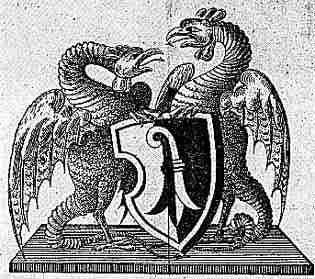

| The basilisk was considered the most poisonous creature on earth. His appearance was allways a matter of dispute. Early wood-cuts (e.g., in Ulisse Aldrovandi: Serpentum et Draconu Historiae libri duo. - Bologna, 1640). show an animal with a domed body, eight legs, a serpentīs tail and a roosterīs head wearing a crown. But allready Athanasius Kircher (Mundus Subterraneus, Roma, 1678) described his later emanation: the cockatrice. Others considered him a dragon. The antique Romans called him "regulus" or little king, not only because of his crown, but because he terrorized all other creatures with his deadly look and poison. His colour was yellow, sometimes with a kind of blackish hue. Plinius mentioned a white spot on his head, which could be misinterpreted as a diadem or a crown. Others speak of three spikes on his forehead. Most authors agree, that Africa was his homeland. There he was hatched from the egg of an ibis or a black stork. His manifestation as cockatrice was rather associated with a roosterīs egg. |  |
Regarding his dangerousness three
main types were distinguished. The golden basilisk poisoned everything by his mere look.
Another with only a golden head terrorized and killed every creature by his evil eye. A
sting of the sanguineous basilisk made the flesh fall off the bones of his victim. All
three had a deadly breath which could even make rocks crumble. The basilisk took his home
in deep wells and rotten cellars or vaults. It is said that mother nature made these
creatures seek these remote dwellings in order to spear both humans and other animals
from its deadly look.
 |
In 1587 a basilisk killed three persons in Warszawa (Poland). Playing hide-and-seek two children - a boy and a girl, both five years old - intended to hide in an old cellar which had been abandoned for 30 years. When they reached the lowest step they suddenly fell dead on the floor. They were not found before the evening, when they were missed by their mothers. A servant was sent out in search. She really found them, but when she went down into the cellar to waken the apparently sleeping children she was herself struck by death. However, an old woman had noticed her entering the abandoned building. She found them all three lying on the ground. All her shouting remained unanswered. Neighbours came and recovered the corpses with long clasps. The bodies were swollen, and so were their lips and tongues. Their skin had turned to yellow. From these signs some learned persons guessed, that a serpent or rather a basilisk had caused their deaths. |
An italian nobleman was killed by a basilisk when he went hunting. For a long time his dog
had barked at a heap of stones when his master tried to find out what embarrassed his dog. He
found a winged serpent. When he tried to slay her, the serpent spread the wings and
blew poisonous breath into his face. At once he fell to the ground and lived just long enough
to tell his companions what he had seen.
Sources:
[ Startseite | Homepage ]
© MCMXCVIII by J. Georg Friebe
& Vorarlberger Naturschau, Dornbirn (Austria)
last update 28.08.1998